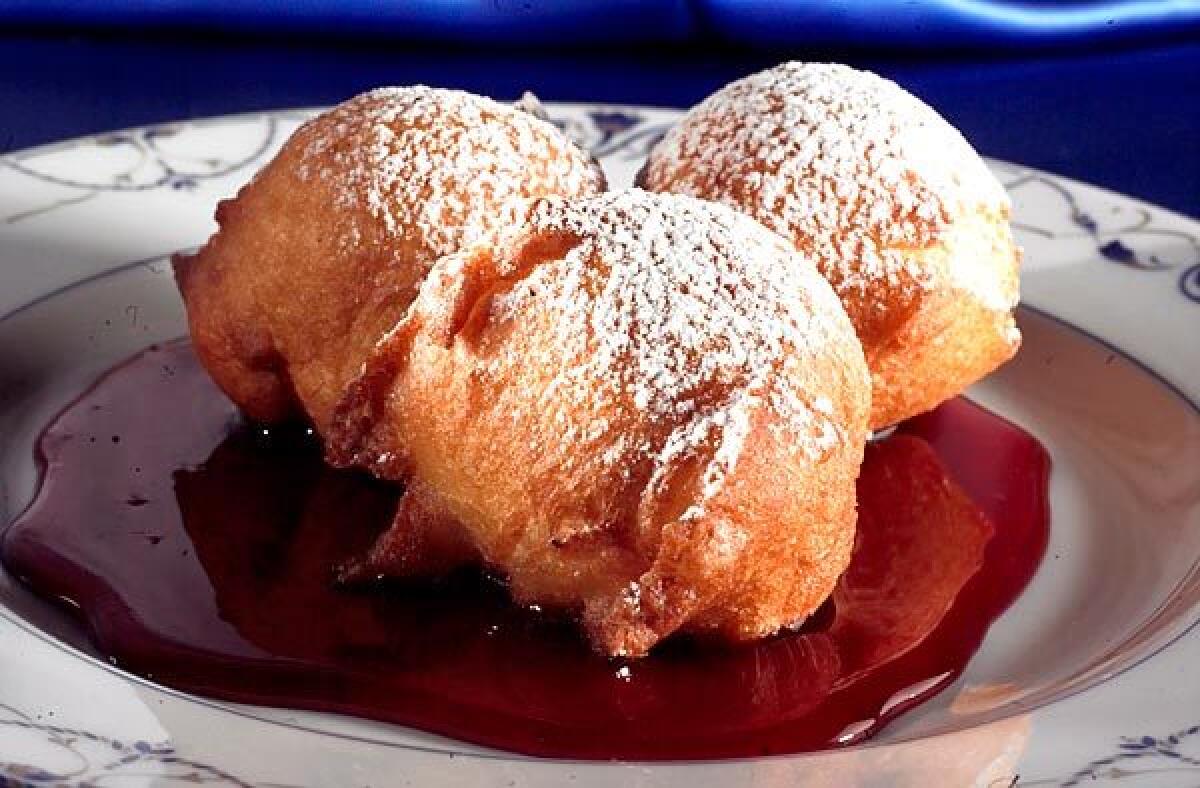For Hanukkah parties, fried foods are a must

Hanukkah begins Friday at sundown, and one of our friends has already purchased colored paper and streamers, multi-colored candles and biodegradable dishes and cutlery for a party. Sheâll buy nuts and bolts at a hardware store for do-it-yourself menorahs, then stop by an arts and crafts store at the neighborhood mall for amusing decorations, such as colored feathers and sparkles, for inspiration.
The trappings of my friendâs party are new, but celebrating Hanukkah goes back centuries. And while itâs nearly impossible to compete with the splendor and spectacle of Christmas, parents, educators and communities in recent years have been working to find creative new ways to instill meaning, relevance and verve to the Hanukkah experience.
And on a holiday that revolves around a one-day supply of oil that miraculously lasted for eight days, part of the celebrating -- with or without the feathers and sparkles -- still means frying.
Holidayâs origins
The Hanukkah story began in 167 BC, when the Syrian-Greek king Antiochus began his campaign to destroy the religious and ethnic identity of the Jewish people living under his control. His plan of action: to pillage the country and defile the holiest place to the Jewish people -- the Great Temple in Jerusalem -- by setting up a statue of Zeus and ordering pig sacrifices on the altar.
But the edicts only served to reinforce the peopleâs religious conviction. In the village of Modiâin, on the outskirts of Jerusalem, the priest Mattathias, or Matityahu, and his five sons founded the intrepid Maccabee warriors, who liberated Jerusalem in 165 BC.
The first thing the Maccabees did was to scour and rededicate the Great Temple, but when they sought to rekindle the menorah at the sanctuaryâs entrance, there was just a small cruse of purified olive oil to be found -- enough to burn for a single day. And then, according to legend, a miracle happened -- instead of one day, the holy oil burned for eight days and nights, just enough time to pick and press fresh olives for oil and bring it to Jerusalem.
According to some sources, the original Hanukkah was actually an eight-day celebration of the fall holiday of Sukkot, which the Maccabees had missed because the temple was defiled. From that year on, they instituted a winter holiday, celebrated with great torches that lighted up the winter nights to commemorate the rededication of the Temple.
Jews around the world still celebrate Hanukkah by lighting a menorah or hanukkiah, some with multicolored candles and purists with traditional olive oil-soaked wicks, adding one light each night until the festivalâs end.
In the years before the Holocaust, Jewish communities throughout Eastern Europe had a special tradition called âNight of the Fifth Candle,â an occasion for long-lost and distant relatives to gather and feast on roast goose or duck, winter vegetables, potato latkes and tea, sing songs, tell riddles, play games, and gamble over nuts with the Hanukkah top called a dreidel.
But you donât have to wait for the fifth night of Hanukkah to enjoy the wonderful bonding tradition of a Hanukkah party -- any night of the holiday will do. Decorate the house with candles, as befitting a Festival of Lights, and if you have an olive tree in the vicinity, you might want to cut a few branches to adorn the table.
Fried foods take center stage. And while the most popular is the potato latke (a crispy fried patty most often consumed with applesauce and sour cream or yogurt), you donât need to be limited by tradition.
Glowing little suns
Mix shredded potatoes with sweet potatoes and parsnips to make latkes that we call Winter Sunshine because they look like glowing little suns -- perfectly appropriate for the Festival of Lights. They can be fried in advance and reheated in the oven (hereâs a tip: to know when the oil is ready for frying, place a sliver of carrot in the oil, and heat till small bubbles form around the edges of the carrot).
Or fry frittatas, which make a nice alternative to the more traditional latkes. Just combine shredded zucchini, feta cheese and eggs with flour and baking powder. After Hanukkah, enjoy the same combination baked in a lightly greased pan, as a crust-less quiche.
The most popular Hanukkah dessert bar none is the Jewish cousin of the jelly doughnut (sufganyiot), made of yeast dough, deep-fried and filled with jam, jelly, dulce de leche and even Nutella chocolate spread. But bumuelos, little round balls of choux-like pastry fried in oil prepared by Jews of Greece and Turkey, are much easier to make. We serve them with a red wine syrup; prepare the syrup in advance, but make the batter at the last minute. Then enjoy the party.
Phyllis Glazer is a food writer living in Tel Aviv, and Miriyam Glazer is a rabbi and professor at the American Jewish University in L.A. They are the authors of âThe Essential Book of Jewish Festival Cooking.â
More to Read
The biggest entertainment stories
Get our big stories about Hollywood, film, television, music, arts, culture and more right in your inbox as soon as they publish.
You may occasionally receive promotional content from the Los Angeles Times.










